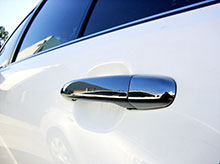What is PVD?
PVD is an environmentally friendly process that provides brilliant and durable decorative finishes
Physical Vapor Deposition (PVD) (Also Known As Thin Film Deposition) Vacuum coating process of vaporizing a solid metal to a plasma of atoms or molecules, vapor that can be deposited as a high performance coating on wide variety of substrates.
PVD is an environmentally friendly process that provides brilliant and durable decorative finishes on household appliances, plumbing fixtures, door hardware, automotive trim, marine fittings, casino, outdoor, sporting equipment, medical instruments, indoor/outdoor lighting, architectural elements and much more.
PVD Coatings Advantages Include:
- Largest coating zones currently available so we can coat large complex shapes or large volumes of small components.
- Flexibility to coat a variety of substrate materials is extremely advantageous, particularly heat sensitive materials like plastic or zinc.
- Sophisticated equipment provide precise process control and computer graphic interface to ensure consistent finish from batch to batch.
- Ability to Deposit Zirconium Nitride (ZrN), Zirconium Carbon Nitride (ZrCN), Chromium Nitride (CrN), Chromium Carbon Nitride (CrCN).
Mixing high purity gases used during the process we obtain specific colors combining the benefits of a decorative finish with excellent wear and corrosion resistance. This thin film provides a protective skin on your product enhancing the visual and functional performance. The PVD coating thickness results between 0.25 microns and 5 microns.
PVD process is very competitive with alternative technologies like
E-coating, Powder Coating and Electroplating. Any material electroplated with Nickel/Chrome or Stainless Steel best support PVD Coatings. The most common chrome plated materials are Brass, Zinc, Steel, Aluminum and ABS plastic. PVD will not dull or enhance the appearance of your product. Polished or mirror surfaces are used to produce PVD polished finishes and brushed or satin surfaces to produce brushed or satin PVD finishes.
Also, PVD Coating will not level or fill like an electroplated finish so surface imperfections will still be visible after the coating process. For example PVD will not fill pin holes or dents, and will not cover scratches on the chrome plating.




